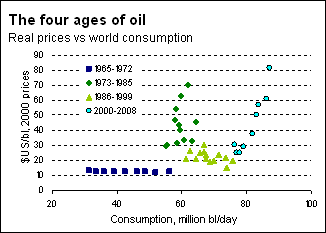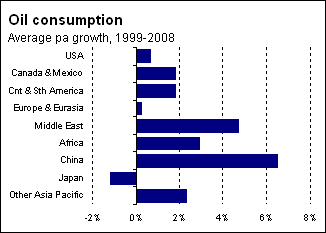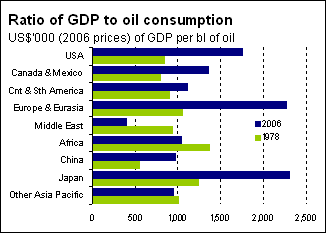What price peak oil?
Long-time readers of our forecasts will probably be aware that, over the last seven years, we have typically expected world oil prices to settle back down over the medium-term, usually US$10-15 below the prevailing level when we’ve been preparing the forecasts. Such a view has not been out of line with the received wisdom. Consensus forecasts for oil prices over the same period have generally tracked the current oil price with some downward adjustment expected over the coming year to bring oil prices back to more "normal" levels. The futures market has generally been a little less sure of any reversal in prices, but even so, an oil price of US$120/bl was never on anyone’s radar even 12 months ago.
With the benefit of hindsight, it has become increasingly clear that the global oil market has entered a new phase since OPEC tentatively looked to restrict production back in 1999. At that time, real oil prices had collapsed to their lowest level since 1973 as the effects of the Asian crisis saw demand growth for oil in 1998 at a six-year low. Graph 1 plots global oil demand against the real oil price in US dollars over the last 40 years, splitting the data into four distinct periods.
- Sixties stability (1965-1973)
- Seventies shocks (1974-1985)
- Cartel-less days (1986-1999)
- Short supply (2000-2008)

Graph 1
A quick history lesson
The 1960s and early 1970s was typified by massive growth in demand for oil, averaging 7.6%pa over the eight-year period. Oil prices were incredibly steady during this time, and actually dipped slightly in real terms. The flat grouping of data points indicates an effectively unlimited supply of oil (relative to demand) during this period.
OPEC’s restrictions on supply led to a 147% increase in the real price in 1974, and a further 114% lift between 1978 and 1980. On average between 1973 and 1985, world oil demand rose at just 0.4%pa, although following each of the two price shocks, there were direct reductions in demand (2.4% between 1973 and 1975, and 10% between 1979 and 1983). The more-or-less vertical grouping of data points indicates a fixed supply of oil and shows the effectiveness of OPEC in restricting the global oil supply.
The breakdown of cooperation in early 1986 between the members of the OPEC cartel saw a resumption of stronger global growth in demand for oil as prices and the restrictions on supply eased. Nevertheless, the disciplines and efficiencies encouraged by the 1970s oil shocks meant that demand growth was much weaker than in the 1960s. Global demand for oil grew on average by 1.7%pa between 1985 and 1999. Overall demand growth during this period was also capped by the collapse of the Soviet Union and the poor performance of the Japanese economy. Although oil prices were less stable than in the 1960s, the grouping of data points again maintained a relatively horizontal pattern, indicating a period of essentially unlimited supply (relative to demand).
Very low oil prices towards the end of the decade saw a renewed push from OPEC to try and restrict supply. The real oil price rose 103% between 1998 and 2000. A recession in the US in 2001 temporarily stalled the upward trend in the oil price, but the subsequent pick-up in economic growth meant that there was no need for OPEC to try and restrict oil production. Despite soaring prices, world demand for oil has grown by an average of 1.6%pa over the last nine years. The grouping of data points for this period is upward-sloping, indicating a traditional supply curve – producers are only able and willing to supply more product as the price rises.
Peak oil of the second derivative
The oil price experience during the current decade indicates that growth in demand is outstripping growth in supply (extraction and/or refining). There has been various one-off events over recent years that have been blamed for driving up prices (eg geopolitical tensions, Hurricane Katrina), but even once these events have passed, we have not seen oil prices drop for any lasting time.
Traditional peak oil theory states that the supply of oil will, at some stage, reach a maximum and then start declining, as production from existing fields slows down and insufficient new supply sources are found. Oil prices skyrocket, resulting in the age of industry, and the world as we know it, coming to an end. However, global oil production is still increasing. Rather than an absolute peak in oil production, the apparent inability of supply to increase as fast as demand is proving to be the critical juncture. Spare oil production capacity previously enabled demand to increase without pushing up the price, but that spare capacity has now been exhausted and supply increases can only be achieved with prices rising also.
Graph 2 shows that the extent of oil demand coming from developing countries, and China in particular. Chinese oil demand has not only grown by 6.5%pa over the last nine years, but an astounding 7%pa on a sustained basis since 1990. A lack of price discipline due to fuel subsidies in the Middle East shows up in their demand growth (petrol in Saudi Arabia costs NZ15c/l, for example). Africa, Asia excluding Japan and China, Latin America, non-OECD Europe, and the former Soviet Union have also lifted their demand faster than the global average since 1999, although in the case of the last two regions, their consumption is still almost 50% lower than 1990 levels.

Graph 2
Graph 3 shows oil consumption versus GDP. The graph indicates that the most highly developed economies are generally also the least oil-intensive in terms of output. In part, this trend reflects the more service-oriented nature of economic activity in developed countries. However, in many cases it also reflects behavioural changes brought about by past price shocks, as well as the petrol taxes applied by many governments to try and control fuel demand growth in the 1970s. In the UK, where petrol taxes are among the highest in the world, the ratio of real GDP to oil consumption improved by more than 200% between 1978 and 2006.

Graph 3
Even in the US, where car usage is synonymous with gas-guzzling, the discipline caused by high oil prices is clear. Since 1978, US oil consumption has risen by just 11%. At the same time, the American economy has expanded by 132%. The 1970s oil shocks (particularly the 1979 event) forced American businesses and consumers tore-evaluate their use of oil, substituting to other energy sources where appropriate, and ensure that the oil they do consume is used efficiently.
The Malthusians predicting the end of civilisation as oil runs out miss one important point – the ability of humans to adapt to changing circumstances. In the past, we have mentioned some of the market dynamics that kick in as oil prices rise and, at least in theory, help to keep the world functioning.
- Biofuels is hardly an auspicious start to the list. The US push to increase ethanol production has essentially been a political decision to try and reduce America’s dependence on Middle East energy supplies, and has had the unintended and unfortunate side-effect of pushing up global food prices. Furthermore, the supposed positive environmental effects of using biofuels instead of fossil fuels are now heavily doubted. Putting aside these issues, given current technology, biofuels start to become economic (i.e. without the need for government subsidies) when the price of oil reaches something like US$150/bl.
- Refining capacity has sometimes been mentioned as a bottleneck in the supply chain. Given the length of time it takes to construct and commission a new refinery, it is possible that increases in refining capacity will take place over the next few years. At best, however, this outcome would only temporarily slow the upward trend in world oil prices. Supply issues further up the chain (i.e. extraction) will dominate price trends over the medium-term.
- Changes in extraction processes are now seeing carbon dioxide pumped into oil wells, whereas water had previously been used. The use of carbon dioxide dramatically improves the potential yield from existing wells from around 30% of the available oil up to between 60% and 80%. This process change represents a potential step up in the extractable oil reserves available.
- New oil fields and different sources of oil start to become viable as the price of oil rises and is sustained at a higher level. Sweet, light crude oil has historically been the primary energy source, but that supply will start to be augmented over the next seven years by "heavy" oil from non-conventional sources such as tar sands and oil shales. However, we note that the local and/or global environmental costs of extracting oil from these sources are significantly higher. For example, the Alberta tar sands in Canada require energy from an average of two barrels of oil to obtain three barrels of oil. The current emphasis on combating global warming suggests that the appetite for using oil from such sources will only diminish further over the medium-term.
- Sustained high oil prices mean that other sources of energy become relatively cheaper and more viable. New Zealand’s electricity supply provides an example of this phenomenon – the viability of wind generation was borderline just a decade ago, but technological improvements and higher electricity prices have meant that wind farms have become increasingly common. Although the world’s current fleet of vehicles can’t easily be converted to run on different fuel, a shift away from reliance on fossil fuels is likely over time. A shift to other energy sources, such as gas, nuclear power, or wind generation, may be more quickly achieved for industry and general electricity supply.
Barring short-term cyclical declines in the pace of economic growth in China, the oil price increases that have occurred are likely to be sustained. We see potential for further real price increases over the next decade, with New Zealand petrol prices climbing to between $2.90/l and $3.70/l. Over the longer-term (20+ years), we would expect real oil prices to start to decline again as the prolonged period of higher energy costs encourages more efficient use of oil (particularly in developing countries, but even in developed economies such as the US). The technological improvements and alternative oil sources mentioned above will also help cap the real price of oil. Finally, the world’s reliance on fossil fuels is likely to decrease over the long term as alternative energy sources become relatively cheaper and are thus increasingly utilised in place of oil.
Given the probability of sustained high prices for oil over the next 10-15 years, we have constructed what we believe to be a realistic scenario for oil demand by 2021 (see Table 1). The scenario involves considerable improvements in the efficiency of oil use around the world, resulting in static or falling demand for oil in the US, Europe, the Middle East, and Japan. However, Table 1 also demonstrates that, even with significant oil efficiency gains in the US, China, and Asia, global demand for oil is still likely to continue rising throughout the next decade as long as economic growth in developing economies remains reasonably strong.

Table 1
The global warming dilemma
It has been interesting to note the public attitude over the last few weeks as petrol prices have climbed towards $2/l. History shows that high fuel prices are an effective method for limiting growth in, or even reducing, consumption. Given the apparent widespread acceptance that we have to do something to combat global warming, one would have expected an acceptance from the public that high fuel prices are a necessary signal for us to change our behaviour.
Instead, the government has found itself under pressure to abandon or delay a number of its key initiatives aimed at addressing environmental issues.
- The biofuel targets look increasingly unlikely to be enacted (whichis probably not such a bad thing anyway, even from an environmental point ofview).
- The imposition of regional petrol taxes looks questionable, despitethe fact that at least some of the revenue generated was to be used forimproving public transport.
- The incorporation of oil into the carbon emissions trading scheme hasbeen delayed from the start of 2009 until the start of 2011.
- Various organisations have been calling for cuts to excise dutyand/or GST on petrol.
The depth of feeling over petrol prices and any the imposition of any further policy-related charges suggests one oftwo things.
- In principle, people are keen to do something to tackle global warming, as long as the cost to them or their lifestyle is not too great.
- Despite policymakers and the media strongly and repeatedly presenting the case for global warming, buy-in from the general public remains much lower than a casual read of the newspaper might indicate.







